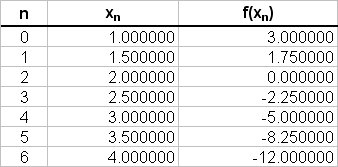Question #adbb5
1 Answer
Trapezium Rule gives:
# int_1^4(4-x^2) \ dx ~~ -9.1250 # (to 4dp)
Simpson's Rule gives:
# int_1^4(4-x^2) \ dx ~~ -9.0000 # (to 4dp)
Exact Answer:
# int_1^4(4-x^2) \ dx = -9 #
Explanation:
The values of
Trapezium Rule
# int_a^bydx ~~ h/2{(y_0+y_n)+2(y_1+y_2+...+y_(n-1))}#
The trapezium rule uses a series of two consecutive ordinates and a best fit straight line to form trapeziums to approximate the area under a curve, It will have 100% accuracy if
So,
# int_1^4(4-x^2) \ dx = 0.5/2 { 3 -12 + 2(1.75 + 0 -2.25 -5 -8.25)} #
# " " = 0.25 { -9 + 2( -13.75 )} #
# " " = 0.25 { -9 -27.5 } #
# " " = 0.25 { -36.5 } #
# " " = -9.125 #
Simpson's Rule:
# int_a^b f(x) \ dx ~~ h/3{(y_0+y_n)+4(y_1+y_3+...)+2(y_2+y_4+...)}#
Simpson's rule uses a series of three consecutive ordinates and a best fit parabola to approximate the area under a curve, It will have 100% accuracy if
So:
# int_1^4(4-x^2) \ dx = 0.5/3 { (3 -12) + 4(1.75 -2.25 -8.25) + 2(0 -5) } #
# " " = 0.166666 {-9 + 4(-8.75) + 2(-5) } #
# " " = 0.166666 {-9 -35 -10 } #
# " " = 0.166666 {-54 } #
# " " = -9 #
Exact Value:
# int_1^4(4-x^2) \ dx = [4x-1/3x^3]_1^4 #
# " " = {16-64/3}-{4-1/3} #
# " " = -16/3-11/3 #
# " " =-9 #


